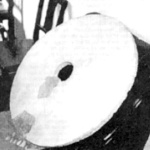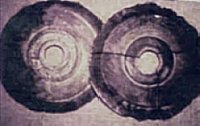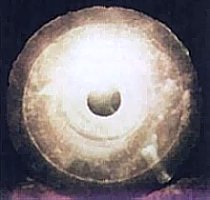
An alleged “Dropa stone”
Note how large it is
A number of publications, particularly on the Ancient Astronaut end of the ‘fringe’ scale, have repeated a story about some stones said to have been found in caves at Bayan Kara Ula in western China. The story became known in the west principally through Erich von Däniken's second and third books, Return to the Stars and Gold of the Gods, although they are also a staple of ufological literature.
The Bayan Kara Ula (Bayan Kara Shan or Bayan Har Shan) region (around 97°E 34°N), in Qinghai (Tsinghai) and Sichuan Provinces, contains the sources of the Tontian He (Yangtse Kiang) and Za Qu (Mekong) Rivers and until relatively recently, it was very isolated. In January 1938, according to the story, Chu Pu Tei, a Chinese archaeologist, made a remarkable discovery in caves in the region. The caves contained a series of graves, while their walls were decorated with drawings of people with elongated heads together with images of the sun, moon and stars. The graves were found to contain the remains of beings little more than a metre tall, with abnormally large skulls. The archaeologists also found a stone disk a little over 300 mm in diameter, with a hole in the centre. A groove on the surface of the disk spiralled outwards from the centre hole to the rim and back, forming a double spiral. Another 716 disks were found in the caves by subsequent investigations.
The disks were sent to a variety of scholars for investigation. One of them, Professor Tsum Um Nui of the Beijing Academy for Ancient Studies, found that the spiral grooves were actually a line of characters written in an unknown language. In 1962, he announced that he had managed to translate the disks. According to his translation, an alien spacecraft crashed in the Bayan Har Shan region twelve thousand years ago. The occupants, aliens called Dropa or Dzopa, could not repair their craft and tried to adapt to conditions on Earth. Meanwhile, the local Ham (or Kam or Kham, depending on the source) tribesmen hunted down and killed most of them. As the Ham were notably short people themselves, it is not clear whether the skeletons found in the caves were those of the Dropa/Dzopa or of Ham tribesmen. Supposedly, the aliens had intermarried with the locals, making identification of the origins of the skeletons more difficult.
The Professor’s publication of his results was greeted with disbelief and he was branded a liar. Resigning from Beijing Academy, he emigrated to Japan, where he died shortly afterwards. Nevertheless, Russian scientists became interested in the disks; several were sent to Moscow, where a chemical analysis found that the disks contained large amounts of cobalt.


Ernst Wegener’s photographs of discs
In 1974, Ernst Wegener, an Austrian engineer, located two of the disks in the Banpo Museum in Xi’an, Shaanxi Province. The museum director could tell him nothing about the disks, which had begun to deteriorate, but she allowed him to photograph them. By 1994, the disks had disappeared.
The earliest source of the story is “Were Alien Visitors on Earth?”, published in the magazine Новое Русское Слово (Russian Digest), dating from 1960 and written by V Ritch and M Chernenko. Intriguingly, this contained the story before the alleged date of Tsum Um Nui’s translation of the disks. More worryingly, Russian Digest is a sensationalistic publication similar to Britain’s Daily Sport and the USA’s National Enquirer. The only other sources – a Belgian UFO magazine, a German vegetarian magazine and a Russian science-fiction magazine – simply repeat the original 1960 story, with no additional information.
Worse, none of the names given in the accounts belongs to anyone who can be shown to have been involved archaeology or linguistics. Tsum Um Nui does not even appear to be a genuine Chinese name! The photos attributed to the otherwise unknown Wegener appear to be genuine, but they merely show stone disks with a hole in the centre and double spirals that are known in Chinese archaeology as part of ancient snake cults. One of the photographs of an alleged disk – not Wegener’s – shows it propped on a chair, clearly with a diameter much larger than the 300 mm claimed by the story.
Last updated 11 March 2006